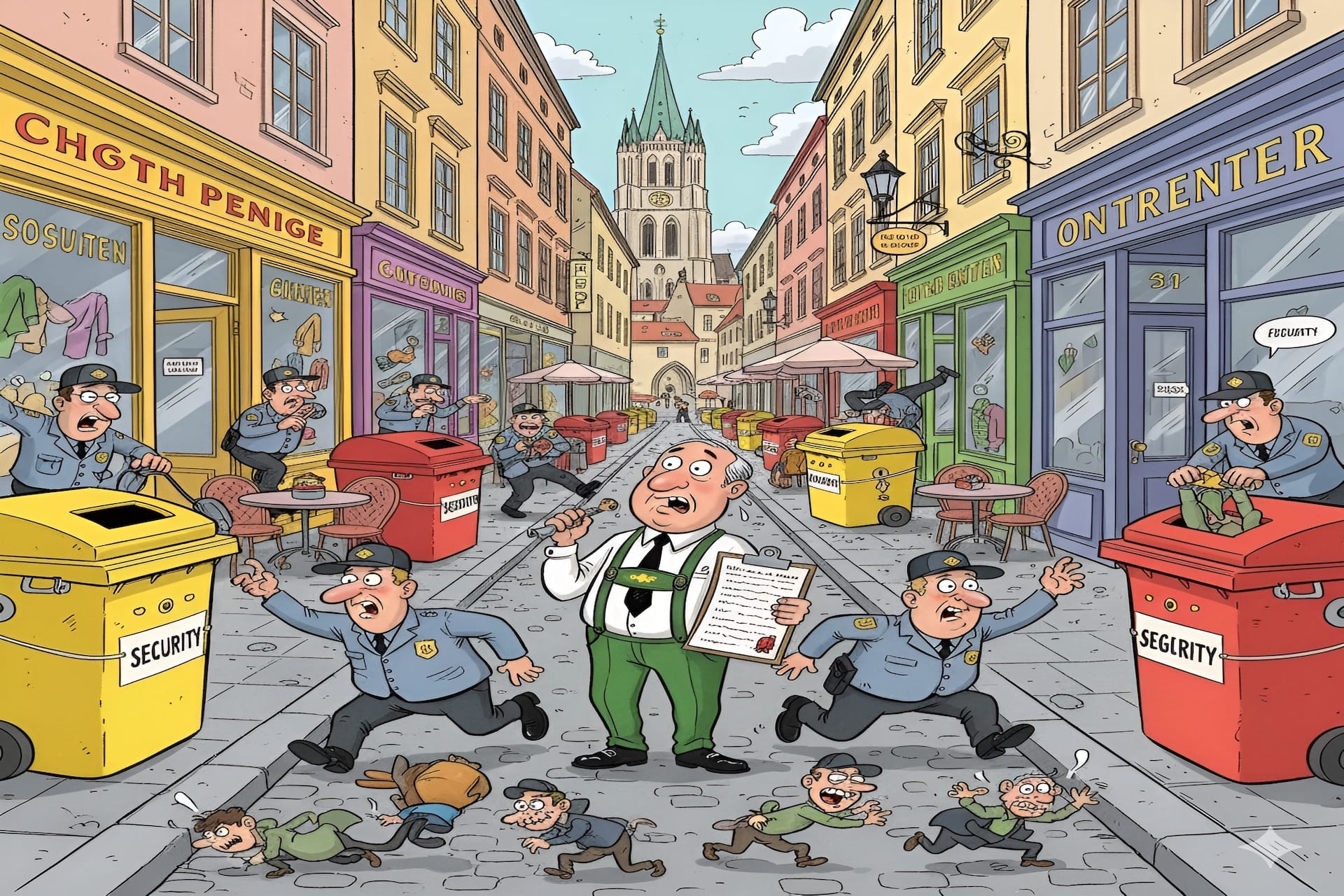Will Vienna Soon Need Security Guards for Every Store – Even Old Clothes Containers?
Vienna faces rising crime, from Naschmarkt café burglaries to looted clothing containers. Discover the causes, solutions, and whether Austria risks needing guards for every shop.
AlpeAnony

Vienna, the capital of Austria, has long been celebrated as one of the safest and most livable cities in the world. However, recent headlines and reports from Austrian newspapers reveal a worrying trend: crime and theft are on the rise. From cafés at the Naschmarkt being burglarized twice within 72 hours to clothing donation containers being looted, public opinion in Austria is asking whether Vienna is facing a deepening security crisis.
This article takes a closer look at the problem, combining facts from Austrian media with broader analysis. It also reflects on the societal, economic, and cultural factors that contribute to crime and examines solutions that can help Austria avoid reaching a point where “security guards are needed for every store, café, or even clothing container on the street.”
The Reality of Crime in Vienna
Viennese life is often associated with coffeehouses, cultural events, and safe public spaces. Yet, a growing number of incidents challenge this perception:
- Clothing donation containers looted: These containers, meant to help people in need, are increasingly targeted by thieves. In a time of fast fashion and over-consumption, they fill up quickly — making them easy prey for opportunistic crime.
- Naschmarkt burglaries: One café owner reported being robbed twice in just three days. Police confirmed that several restaurants and shops in the Naschmarkt area faced break-ins in the same pattern.
- Street crime and drug issues: Public spaces in Vienna have become flashpoints for drug consumption and trafficking, with rising levels of violence connected to addiction and lack of social control.
Taken together, these developments highlight deficiencies across Austrian agencies — from law enforcement to social policy — in dealing with crime and its root causes.
Beyond Policing: Crime as a Social Issue
It is tempting to view crime purely as a police issue. However, Austrian society must confront the fact that crime is not only a security problem but also a social one. Drug addiction, unemployment, poverty, and urban neglect are interconnected drivers of criminal activity.
Experts in criminology emphasize that reducing crime requires a multi-dimensional approach:
- Community-based prevention – Crime thrives in areas where social bonds are weak. Building stronger community networks, from neighborhood watch groups to local cultural programs, can reduce violence.
- Environmental design – Poorly lit streets, abandoned lots, and unsecured properties create opportunities for criminals. Vienna needs investment in urban planning and infrastructure to reduce situational risks.
- Education and employment – Long-term crime prevention depends on reducing inequality. Offering young people access to vocational training and jobs keeps them from drifting into criminal activity.
- Mental health and addiction services – Many crimes are linked to untreated psychological issues or drug dependency. Expanding healthcare access can address root causes before they result in theft or violence.
The Shortage of Police in Vienna
According to Austrian newspapers, Vienna faced a shortage of 1,500 police officers since the spring of 2024. Even if the authorities succeed in filling these vacancies by the end of 2025, sheer numbers may not solve the crisis.
Security is not only about manpower. More police on the streets may deter some crimes, but without addressing the deeper social issues, the cycle of crime will continue. If Austria only focuses on police recruitment, the city may one day truly require security guards not just for every shop, but even for clothing donation containers.
Investing in Infrastructure and Technology
A major weakness in Austria’s fight against crime is infrastructure and technology.
- Poor surveillance quality: Many Austrian newspapers have published photos of suspects that are too blurry to identify. This undermines the entire judicial process and emboldens criminals.
- Lighting and urban design: Dark streets and neglected public spaces create conditions for crime. Targeted investments in lighting, clear lines of sight, and secure building design can significantly reduce burglaries and assaults.
- Digital infrastructure: Modern crime prevention requires AI-powered surveillance, real-time reporting systems, and data-driven policing strategies. Austria has been slow in adopting these innovations compared to other European states.
Why Crime Feels More Visible in 2025
Public opinion in Austria perceives crime as rising sharply, but is it truly an explosion or partly a matter of perception? Experts suggest three overlapping dynamics:
- More reporting: Social media and online newspapers amplify every incident, making crime feel more prevalent.
- Visible poverty: The gap between Austria’s “social state” model and those left behind by globalization and inflation is widening, making social tensions more visible.
- Drug epidemic: The rise of synthetic drugs has created new patterns of street crime that feel more chaotic and harder to control.
Thus, while statistics may not yet show Vienna as an unsafe city compared to global standards, the psychological impactof constant theft reports cannot be underestimated.
My Perspective: A Shot Across the Bow for Austrian Authorities
As an Austrian citizen and observer, I see these developments as a warning sign. Austria has long prided itself on security, stability, and fairness. But ignoring these trends risks undermining the very qualities that make Vienna special.
From my point of view, the real danger is complacency. If we accept crime as “normal,” we will one day need private security for every shop, every café, and even every container of donated clothes. That is not the Vienna we want.
Austria must invest not only in police numbers but also in:
- Better surveillance technology.
- Mental health and addiction programs.
- Educational and vocational opportunities.
- Stronger community and family support systems.
Only then can Vienna avoid becoming a city where fear dictates daily life.
Conclusion: The Future of Security in Vienna
Crime and theft in Vienna reflect broader European challenges — balancing social welfare with public safety in an era of inequality, migration, and rapid social change. The solution lies in unity between institutions: police, government, schools, healthcare, and communities must work together.
If Austria invests in people as much as in policing, then crime will become unattractive and rare. If not, the pessimistic prediction may come true: a security guard for every store and every clothing container in Vienna.
